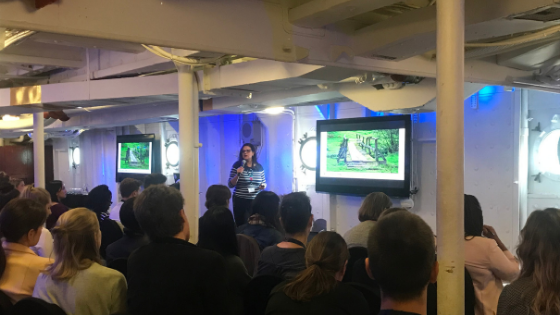Tips and tricks for the non-profit marketer


Being part of such a demanding and pressurized industry is not easy. For years, Dotdigital has been working to deliver solutions to many NFP pain points. That’s why the Dotdigital platform is the choice for so many non-profit organizations. We decided to unite our years of insight with the current trends in marketing and use cases of the innovative work happening right now, in an event dedicated solely to helping NFPs work smarter and deliver big.
(P.S. it was on a really big boat)
So, without any further ado, here are the key takeaways we learned aboard HMS Belfast:
Make everything you do T.A.S.T.E-y
As a not-for-profit organization, you’ve probably done extensive research into the personas of your donors and volunteers. But, do you remember to apply it in your marketing comms?
Probably not.
Gavin Laugenie, Head of Strategy & Insight at Dotdigital, broke down the simple tactics you can adopt to ensure your content makes an impact with every type of donor.
Trust
Without trust in your organization, no one is going to be willing to donate their time or money. NFPs, and charities, in particular, suffered massive blows to the amount of trust the public had in them in 2018. It’s more important than ever to the public that NFPs be open and honest about everything they do.
You need to continuously reinforce the message that your non-profit will put resources to the best use. Whenever you’re publicly recognized in the press, or on social channels, be sure to include it in your emails. Especially in the early stages of the customers’ journey with you.
Altruism
Altruism and a general concern for the wellbeing of others is considered to be the most powerful reason people decide to donate or volunteer for a charity.

Utilize this in your marketing. Include pictures of your volunteers at work. Create videos of your work and your volunteers on the front line. Visuals like these in your email marketing specifically can be very powerful. They show the real impact you are making to your mission and spur your altruistic subscribers to contribute in any way they can.
Social
Never forget about the emotional connection people may have to your cause. It may be that someone close to them cares about your mission or has been affected by it personally. That’s often the reason married couples donate together, and friends join fun runs as a group.
Tell human stories that help people connect with your organization, and really drive home the social impact their contributions have helped provide. Videos are particularly impactful here. Just think about the impact the stories featured in Stand Up 2 Cancer have every year. If they can feel they can relate to your story, the more likely they will be to get involved.
Taxes
This may not feel like a natural reason, but it resonates with a lot of people today. Especially your high-value givers. Tax breaks for charitable giving are well established in countries such as the US, but in the UK, it more often than not comes in the form of the Gift Aid scheme. And, this is only really brought up when someone is already in the process of donating.
In your email marketing, creating targeted campaigns around Gift Aid, especially around the holiday season, is a great way of generating awareness and driving donations.
Egoism
People donate or volunteer because of the way it makes them feel. They might not want to phrase it that way, but these donors or volunteers experience a positive feeling similar to a buyer’s high when the act is charitable.
Make sure you say, ‘thank you’ and ‘you’ve made a real difference today’. It’s a great way to encourage these donors and volunteers to repeat their actions. Also, using language like ‘even a little bit makes a big difference’ or asking them to donate time, not money, can make people feel good, without stumbling over the issue of financial constraints.
Breaking the status quo
Jamie Walker and Najmah Salam are still relatively new to Help for Heroes, but they’re at the start of a very exciting journey.
Aware that email is an unbeatable channel to engage audiences and drive donations, they have looked at today’s savvy subscriber and decided that they needed to do something new. Audiences are constantly bombarded by marketing on every channel. Cutting through the noise as an NFP is even harder because you’re not just asking someone to read your email, but do something – really do something – too.
As a result, they’ve decided to adopt a new approach – #respectheinbox.
But how? And what does it mean?
Automate for humans
Some people worry automated emails take the human touch out of the message – but this really isn’t the case. You just have to make sure you do it well.
Adding ‘Meet the Team’ emails to your drip or welcome campaigns can create a personal connection with readers. Asking for feedback demonstrates the value you put in their opinions. RSS feeds give a live update of what’s happening in your organization. It also makes it easier for you to take readers on individual journeys based on whether they’re supporters or beneficiaries.
These are just some easy ways to keep your messages personal while saving you time to do what humans do best: create, invent, and innovate.
Less is more
Always be mindful of decision fatigue. The average office worker receives around 121 emails a day. Handheld devices are checked between 80 and 150 time a day. If you overwhelm your email with too much information, it’s simply not going to go in and your impact will be lost.
Keep emails short and punchy. If you’re asking for donations, sign-ups, or any kind of action, make sure the message in your email is singular
Read the room
Understand the climate, practice empathy, and remember that timeliness is effectiveness. This can come in many forms such as asking for consent before sending emails around the holidays. For Help for Heroes, this has recently been put into practice as they continuously keep supporters informed about the progress of the new Office of Veterans Affairs.
This helps you build momentum, and keeps subscribers engaged.
There’s a time and a place
In other words, don’t be a one-trick pony. Just because data proves that first name personalization in a subject line increases open rates, doesn’t mean every subject line needs to be.

By constantly testing and learning, you’ll soon develop a bank of magic tricks you can pull out to reach your audience at the right time, and in the right place.
By respecting the inbox, Help for Heroes is ensuring that the emails it sends are relevant and engaging. Donors have busy lives, so holding their attention is essential. Adopting this approach is helping Help for Heroes on their mission.
Don’t let fear hold you back
Barry McVeigh of Macmillan Cancer Support and Ralph Johnson from Felinesoft had a single objective when they started working together: help more people, faster!
Macmillan Cancer Support, like many charities in the NFP sector, had left its technology systems in the past as it focused almost entirely on its mission. With its objective in mind, Macmillan turned to Felinesoft to help it accelerate its impact through technology and innovation.
This required a drastic change in the way the whole organization acted. Cultural change is never easy, but the success of Macmillan and Felinesoft’s work proves that you must never let fear hold you back. Macmillan had a decision-making process that was almost too inclusive, a waterfall approach to information sharing and high demands for success. This slowed the process of change, making innovation hard.

Together, the two organizations identified the iterative process needed to successfully innovate:
Understand where you are
Start at the very beginning. Yes, you’ll have an end goal, but you can’t get there before you understand where you are today. Evaluate your key metrics, understand the user journey, and how the conversion funnel works.
Generate ideas
Once you know where you are, think about where you want to be. How can you improve your key metrics or the user journey? Empathy is essential to think about what the ideal journey should be.
Get feedback
Feedback from stakeholders is essential. But don’t forget, too many cooks spoil the broth. Get together small focus groups where you can work collaboratively on a solution. Small teams move faster and get to work quicker.
Build and test
You need to be focused on implementation if you’re going to get something done. Act fast and start building your solution as quickly as possible. Testing everything you do is the only way you’ll know if it’s working.
Always be optimizing
Arguably the most important part, never be afraid to fail. By closely monitoring your goals and KPIs, you’ll soon find out what’s working and what’s not. Without this environment of trust, change is never going to happen.
First impressions count
Data, data, data.

There really is nothing more important to the modern marketer than data. Without data, we can’t engage customers. And for an NFP, an unengaged subscriber is stopping them from getting closer to their mission.
For the founder of eFocus Marketing, Kate Barrett, the second someone subscribes to your newsletter, you need to work hard to engage them, and keep them engaged. Kate looked at a small sample of NFPs and identified three key mistakes that were far too common for a modern marketer.
Opting in was hard
60% of brands had no clearly visible email opt-in on the homepage.
When someone enters your website, they’re expressing an interest in you, so it’s vital to connect with them as soon as possible. Collecting details from these interested parties means you can inspire, educate, and nurture them until they’re ready to donate.
What’s worse is that Kate discovered 30% of NFPs didn’t even offer a newsletter opt-in at the end of a donation. These are people clearly committed to helping you achieve your mission, and they are passing you by, potentially shifting their interests to a more engaging organization with a similar proposition.
Whether you choose to use a popover or a form in your footer, making it easy to subscribe is essential.
Welcome programs were lacking
Even with nearly half of NFPs sending welcome emails, there’s still a long way for brands to go.
Your welcome email is your first interaction with a potential supporter. To really drive and inspire action you need to be telling them your story. What do you do? Who do you help? Why is it important? And, how can they make a difference?
Break these up into a series of welcome emails and make sure you keep the CTAs to 1 max. per email. Consider carefully what your important messages are, and make sure you’re communicating these from the start.
Communications weren’t continuing
A single welcome email or ‘thank you for your donation’ is just the start of the journey. Making communications personal to the reader helps you keep supporters coming back to your cause.
If they’ve donated, don’t leave it at thank you. Show them how their money is being used and the progress that is being made thanks to them. If they’re regular fundraisers, show them how much they’ve raised and whose lives they’ve made a difference to.
To avoid these mistakes, you need to know your audience. The data you have on them facilitates the conversation – you just need to use it to get maximum returns on your emails marketing.


